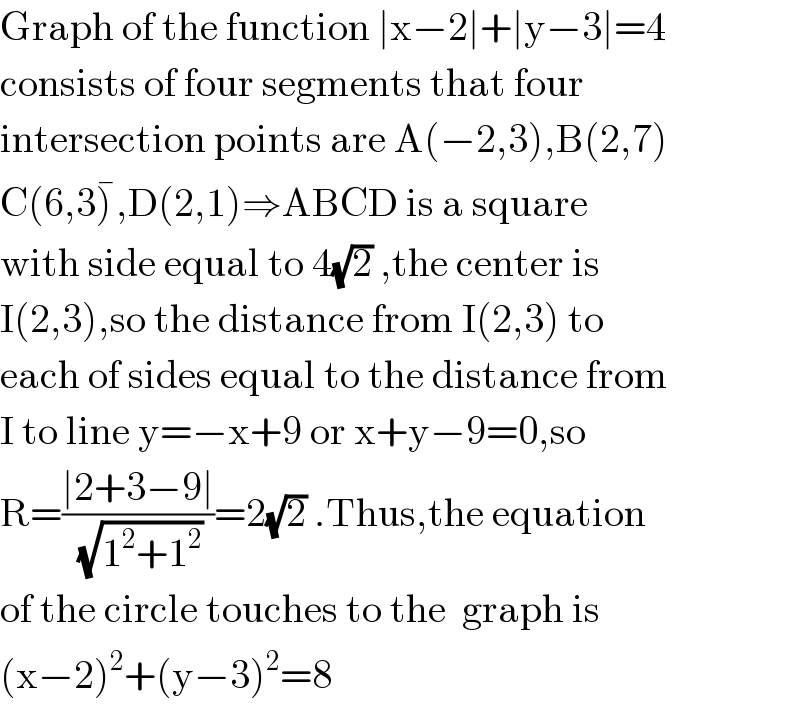Question Number 115261 by bobhans last updated on 24/Sep/20

$${Equation}\:{of}\:{circle}\:{touching}\:{the}\:{line}\: \\ $$$$\mid{x}−\mathrm{2}\mid+\mid{y}−\mathrm{3}\mid\:=\:\mathrm{4}\:{will}\:{be}\: \\ $$
Answered by john santu last updated on 24/Sep/20

$${centre}\:{of}\:{circle}\:{is}\:{a}\:{point}\:\left(\mathrm{2},\mathrm{3}\right) \\ $$$${with}\:{radius}\:=\:\frac{\mid\mathrm{2}+\mathrm{3}−\mathrm{9}\mid}{\:\sqrt{\mathrm{2}}}\:=\mathrm{2}\sqrt{\mathrm{2}} \\ $$$${equation}\:{of}\:{circle}\:{is}\: \\ $$$$\left({x}−\mathrm{2}\right)^{\mathrm{2}} +\left({y}−\mathrm{3}\right)^{\mathrm{2}} =\mathrm{8} \\ $$
Answered by 1549442205PVT last updated on 24/Sep/20

$$\mathrm{Graph}\:\mathrm{of}\:\mathrm{the}\:\mathrm{function}\:\mid\mathrm{x}−\mathrm{2}\mid+\mid\mathrm{y}−\mathrm{3}\mid=\mathrm{4} \\ $$$$\mathrm{consists}\:\mathrm{of}\:\mathrm{four}\:\mathrm{segments}\:\mathrm{that}\:\mathrm{four} \\ $$$$\mathrm{intersection}\:\mathrm{points}\:\mathrm{are}\:\mathrm{A}\left(−\mathrm{2},\mathrm{3}\right),\mathrm{B}\left(\mathrm{2},\mathrm{7}\right) \\ $$$$\mathrm{C}\left(\mathrm{6},\mathrm{3}\bar {\right)},\mathrm{D}\left(\mathrm{2},\mathrm{1}\right)\Rightarrow\mathrm{ABCD}\:\mathrm{is}\:\mathrm{a}\:\mathrm{square} \\ $$$$\mathrm{with}\:\mathrm{side}\:\mathrm{equal}\:\mathrm{to}\:\mathrm{4}\sqrt{\mathrm{2}}\:,\mathrm{the}\:\mathrm{center}\:\mathrm{is} \\ $$$$\mathrm{I}\left(\mathrm{2},\mathrm{3}\right),\mathrm{so}\:\mathrm{the}\:\mathrm{distance}\:\mathrm{from}\:\mathrm{I}\left(\mathrm{2},\mathrm{3}\right)\:\mathrm{to} \\ $$$$\mathrm{each}\:\mathrm{of}\:\mathrm{sides}\:\mathrm{equal}\:\mathrm{to}\:\mathrm{the}\:\mathrm{distance}\:\mathrm{from} \\ $$$$\mathrm{I}\:\mathrm{to}\:\mathrm{line}\:\mathrm{y}=−\mathrm{x}+\mathrm{9}\:\mathrm{or}\:\mathrm{x}+\mathrm{y}−\mathrm{9}=\mathrm{0},\mathrm{so} \\ $$$$\mathrm{R}=\frac{\mid\mathrm{2}+\mathrm{3}−\mathrm{9}\mid}{\:\sqrt{\mathrm{1}^{\mathrm{2}} +\mathrm{1}^{\mathrm{2}} }}=\mathrm{2}\sqrt{\mathrm{2}}\:.\mathrm{Thus},\mathrm{the}\:\mathrm{equation} \\ $$$$\mathrm{of}\:\mathrm{the}\:\mathrm{circle}\:\mathrm{touches}\:\mathrm{to}\:\mathrm{the}\:\:\mathrm{graph}\:\mathrm{is} \\ $$$$\left(\mathrm{x}−\mathrm{2}\right)^{\mathrm{2}} +\left(\mathrm{y}−\mathrm{3}\right)^{\mathrm{2}} =\mathrm{8} \\ $$
